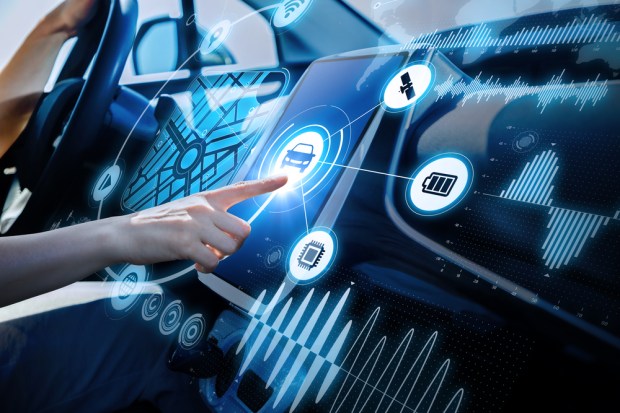Why Google Wants To Ride Shotgun With Automobile OEMs

In the quickly developing world of voice-controlled artificial intelligence, the car is shaping up to be the newest battleground.
It is territory that it makes sense to fight for, as more than 95 percent of all vehicle journeys are made with intent. The AI system that can understand that intent suddenly has a lot of monetizable opportunities to reach that customer in context – and there is a lot of commerce context to choose from.
The average American has a 51-minute round-trip commute five days a week, and commuters collectively spend $230 billion annually during those trips. And those commuter-consumers, according to the PYMNTS/Visa How We Will Pay survey, are looking to connected cars and the convenience they can offer around things like buying gas, ordering coffee and paying tolls when it comes to the future of their daily rides.
Moreover, as the PYMNTS Digital Drive Report indicates, those same commuters seem to be affirming that their favorite co-pilot for these rides are their voice assistants. By the numbers, 53.3 percent of commuters are already turning to voice assistants while driving.
“Voice options have changed the relationship between commuters, devices and the apps commuters use to interact with the commuting commerce ecosystem,” the report found.
Which voice assistant will get to sit shotgun, however, remains to be seen. Amazon’s biggest jump forward lately has been the release of Alexa Auto, an in-car device that pairs with a user’s phone and allows them to interact with Alexa through the car’s infotainment system. The device is also compatible with third-party apps like Google Maps and music options including Amazon Music, Spotify, Pandora, SiriusXM and NPR. Apple Maps and Apple Music are expected to be added soon.
Last year, Amazon also released the Alexa Auto Core (AAC) SDK, or Alexa Auto SDK, to allow automakers to integrate Alexa voice control into a car’s infotainment system. The SDK is designed to bring Alexa to in-car dashboards for many common hands-free, voice-controlled tasks, such as playing music, providing turn-by-turn directions from native navigation systems, finding local businesses and making phone calls.
Google, on the other hand, has spent the last several years pondering how to get its Assistant somewhat more deeply embedded into automotive systems, with an Android-based operating system for cars that runs independently of a smartphone or any other device.
That is a different conception of Android Auto than exists today, which is an API bridge that allows apps on Android phones to run on the vehicle’s infotainment unit. Instead, this is intended as a full implementation of Android software in the infotainment unit itself.
Google has struck deals with Volvo and Audi to start rolling out these systems in 2020.
And these more fully implemented systems are the future of the connected car ecosystem, according to Patrick Brady, the head of Android Auto. Because the bifurcated experience – where cars are really running two systems that connect to one another, isn’t ideal.
“CarPlay and Android Auto are great in that they allow you to bring your digital ecosystem into the car,” he said. “But it does present to you as a consumer that you have two worlds, you need to deal with the native system and your smartphone at the same time. That’s not necessarily what consumers asked for.”
What users have demonstrated time and again that they want, as Brady noted, are seamlessly smooth transitions, so that what they are used to doing with their voice assistant in one context can easily slide into a new one. For Google, that has meant building Android Auto into a “fully turnkey solution of automotive,” so that it does everything in the same way. That includes vehicle subsystem control, such as the heating and air conditioning, as well as access to thousands of Android Auto apps.
“I think what people want is to never feel the need to reach for their phone,” Brady said. “But you want to be able to get into a car and have your digital life flow seamlessly, and take advantage of all the digital real estate in the car, and feel like it’s naturally integrated and it’s all there, available for you. You don’t plug in, you don’t sign in. It’s just there. And when you leave, it goes with you. And it gets better as you use it.”
The difference between what is available now and what the future of connectedness should look like, Brady said, is the difference between getting two separate systems to talk with each other versus simply building a single system. That is what they are working on creating via their partnerships with Volvo and Audi – and that, he noted, is the best road to the best user experience possible.
“You know, the main distinction will be that you’ll actually have the app ecosystem. That is a huge thing. And also, I think you’ll see a more modern system come out of it, because we’re adding capabilities and features into Android to make it more appropriate for automotive,” Brady noted.
Avoiding the Fate of the Phones
The question remains, however, whether vehicle manufacturers really want to integrate that tightly with Google, and hand over quite as much data as full integration entails. Android Auto today doesn’t have access to the full range of sensor data that the car produces. Many critics have pointed out that by giving Google all of that access, automakers run the risk of finding themselves in the same position as handset makers: another conduit by which Google can deliver its ecosystem to its users. Automakers would essentially be giving up control of digital differentiation to Google.
“This has yet to happen in the vehicle, and the only thing standing between vehicle makers becoming handsets on wheels is the lock they currently have on the digital data that the vehicle generates,” Brady pointed out. “OEMs need to keep Google out of their sensor data, and at the same time they must improve their user experiences so that drivers stop using their phones and engage with the infotainment unit,” one columnist for Forbes noted.
But Google noted there are some problems with that view. First, it assumes that creating a perfectly streamlined digital user experience is something that every car maker wants to do, or has the ability to do on their own.
“One thing we’ve found is that it’s very hard to create a platform,” Brady stated. “Anyone can create an operating system, but it’s hard to create a platform that is relevant to developers and gets developer attention.”
Second, Brady said, these outlooks tend to overlook the amount of creative control OEMs can maintain in this process. Google has standards that auto manufacturers need to adhere to, but those standards are not so rigid that the ability to apply any creativity is rendered moot.
“A lot of people assume that’s very stringent, and that we say, ‘you must have a home screen that presents apps in a grid,’ or something like that. That’s not the case,” Brady noted. “We want to leave carmakers, or mobile manufacturers, whoever it may be, a lot of room to innovate – as long as it doesn’t break some of the core tenets of the platform as they apply to consumers and developers.”
Finally, he added, there is more alignment in goals between Google and auto manufacturers than is being considered. Everyone wants to create a seamless experience – making it easy for consumers to completely navigate their cars without ever looking at their phones is a shared goal. The question is how to build on that shared goal in a way that works for automakers instead of feeling like it’s encroaching on them.
“We’re really focused on making it the best possible solution for carmakers. And so we tell them, ‘look, if you choose not to go with Android, we want to know why, because it means our job’s not done, and we need to go invest and fill those gaps.’”
Will it work?
So far, the going seems to have been slow, as only Audi and Volvo have officially signed on for the deluxe edition of Android Auto so far, and there are no cars on the road yet. Meanwhile, Alexa Auto has sold out of the limited release, and a long waiting list is forming. Google might be building an ideal voice experience at present, but one with limited exposure. If Alexa can secure a co-pilot job in a bulk of cars, Amazon gets a chance to grab a much wider share of the market than Google.
If Google can optimize the experience well enough with its partners so that the Google Assistant and Android operating system becomes a selling feature, it might have found an interesting tactic in running the race on depth and not breadth. But team Android will need a lot more than two solid partners to make that work.
We’ll keep you posted as to who else signs on.
